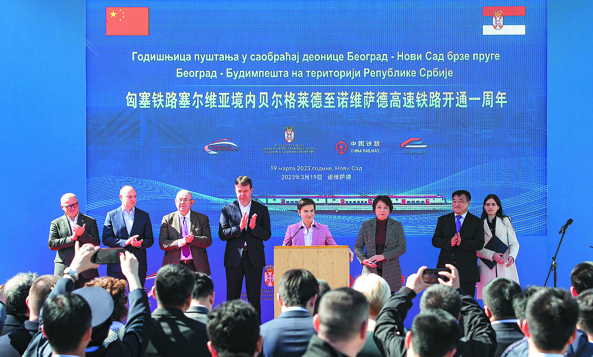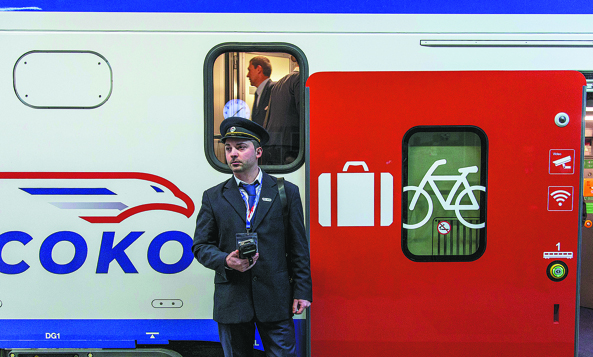China Daily | April 28, 2023

Serbian Prime Minister Ana Brnabic (fourth from right) addresses a ceremony in celebration of the first anniversary of the operation of the Belgrade-Novi Sad section of the Belgrade-Budapest Railway in Novi Sad on March 19. (Xinhua/Wang Wei)
This year marks the 10th anniversary of the launch of the Belt and Road Initiative. A decade of practice has demonstrated that it's a broad and prosperous way for China and the world to share opportunities and seek common development. In a more than 10-part series, China Daily finds out how the road of peace, prosperity, openness, green development, innovation and civilization will contribute more to the shared future of mankind.
Completion of Serbian rail link to cut journey duration by two-thirds
The railway line between the Serbian capital Belgrade and the Hungarian capital Budapest dates back to the inauguration in 1883 of the Orient Express, connecting Paris with what is today Istanbul.
While the 75-kilometer section of track linking Serbia's two largest cities, Belgrade and Novi Sad, has been renovated over those 140 years, until 13 months ago the journey took 90 minutes, with trains trundling along at a graceful 40 km/h.
That all changed on March 19 last year when a high-speed train that started running that day cut travel time to about 30 minutes. In the first year of its operation, the service carried nearly 3 million passengers, that in a country of 7 million people.
The Belgrade-Novi Sad section is part of the 342-km Belgrade-Budapest high-speed railway, which, upon completion in 2025, will shorten the rail trip between the two capitals from the current eight hours to less than three. The design speed is 200 km/h on the 183-km Serbian section and 160 km/h on the 159-km Hungarian section.
Serbia's Prime Minister Ana Brnabic took a ride on the high-speed railway on March 19 from Belgrade to Novi Sad to attend the ceremony marking the one-year anniversary.
A Chinese consortium formed by the China Railway International Corporation and China Communications Construction Corporation, or CCCC, helped build the high-speed railway. Russian, Swiss and German companies have also had a role.
"What we inaugurated a year ago today is not just high-speed rail, but is also a milestone in Serbia's development," Brnabic said. "Today is an extremely important day. By the end of next year it will only take one hour from Belgrade to Subotica," Brnabic said, referring to the completion of the Serbian section of the Budapest-Belgrade high-speed railway.
"We have a big dream. Our plan is to bring more Chinese investors to Serbia and to promote the exchange of science and technology between the two countries. China is our great cooperation partner and a trustworthy friend in realizing our dream."

A train attendant waits for passengers to board in Belgrade, Serbia, on March 19. (Xinhua/Wang Wei)
Less than 20 days later on April 6, workers at the Chinese joint venture started to lay tracks on the 108-km section from Novi Sad to Subotica, a Serbian city bordering Hungary. The section will have a total of 49 overpasses, underpasses and viaducts, with the largest viaduct to be built near Vrbas about 1.6 km long.
Serbia's Minister of Construction, Transport and Infrastructure Goran Vesic announced last month that construction of the section will be completed by the end of next year.
The Mayor of Novi Sad, Milan Duric, said he has seen the good quality of the high-speed railway in the past year. "I'm fully confident that we will travel to Subotica on a high-speed railway by the end of next year," he said.
Duan Wei, the deputy chief engineer of the Chinese joint venture, appeared sentimental on the one-year anniversary.
Since arriving in Serbia to work on the project in August 2018 he has returned to China only once, at the end of 2018. A mountain of work and the pandemic kept him from seeing his wife and young daughter, a second-grader in elementary school, in person.
"I feel sorry for my family for not being able to join them during Spring Festivals," he said. However, Duan said he feels proud to be part of a key project of the Belt and Road Initiative.
Jelena Gavric, a native of Novi Sad, did a live broadcast relating to the high-speed railway on the anniversary of its inauguration.
Gavric, who speaks fluent Chinese, and who has worked on the joint venture for the previous four months, said Serbians are grateful for these kinds of projects and for China's help.
"It makes me happy as well," said Gavric, who has spent seven years in China and has become a well-known social media influencer on Chinese social media apps such as Weibo, Douyin and Bilibili. "Serbia and the West Balkans need more modern projects, and hopefully China will play an important role in modernizing this region."
Chinese companies have been active in other infrastructure construction projects in Serbia.
PowerChina, which has also built highways in Serbia, is undertaking the civil engineering for Belgrade's subway projects, which also involves the French company Alstom.
Serbia's President Aleksandar Vucic said last year that he was pleased with the Chinese and French companies that are the main contractors on the subway project as well as domestic companies that have been chosen as subcontractors.
The City Manager of Belgrade, Miroslav Cuckovic, said recently that the city authorities would sign a contract with the German rail company Deutsche Bahn in early May to become the main supervisor of the subway project.
He told local media RTS that the Belgrade subway will be the second fully automated, driverless subway in the world, the other being in Qatar.
Belgrade hopes to complete its first subway line, 21 km long with 21 stations, from Zeleznik to Mirijevo, by 2027 and a line of the same length with 23 stations from Mirijevo to Zemun, by 2030.
China Road and Bridge Corporation, a subsidiary of CCCC, has been commissioned by the Serbian government to build wastewater treatment plants in 65 municipalities across the country.
Serbia, a candidate for membership in the European Union, must meet EU environmental standards before it can become a member.
During the signing ceremony for the sewage treatment project in 2021, Serbia's then minister of construction, transport and infrastructure Tomislav Momirovic described the project as "Serbia's boldly stepping into the future and creating a modern, functional state".
On April 12, Momirovic, now minister of domestic and foreign trade, was in Beijing signing a memorandum of understanding with China's Minister of Commerce Wang Wentao on starting negotiations on a free-trade agreement.
Wang described Serbia as an "ironclad friend" of China and said his country is willing to invest in the free trade agreement negotiations.
Momirovic said such an agreement would create a favorable environment and Serbia is willing to work with China to promote negotiations.

